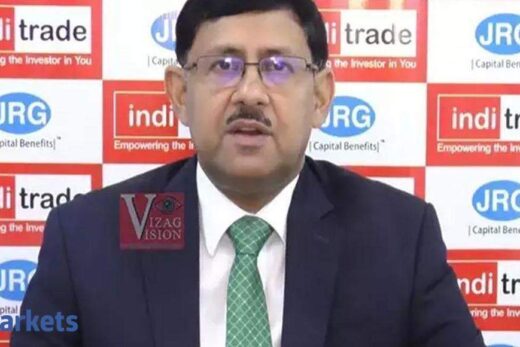There are lots of ways to make money in this market. Metals, banks are going higher. IT is holding on. Pharma comeback has been real. It is a problem of plenty. Isn’t it?
The point is that the market has been one-way all along. After the Budget, it has gone up 10 odd percent which is creating sweat for us because we want our new customers also to make money. The perception trade of ‘14 was quite fluid because it was not supported by fundamentals. But this time around, it has been fundamentally supported. When Covid hit last year, the world was slowing down; India was slowing down. The GDP was down to 4% for the last calendar quarter of 2019 which was a big drop from 6.5% that we had reported.
So what happened after the pandemic hit us was that the slowdown which would have lasted for a painful couple of years, got compressed into a quarter or two and then the QoQ growth started moving up. This time around, earnings is supporting this run. We have been around for the last 25 years and we just followed three simple strategies or rather one strategy but three themes which gives us a long runway of growth. The first of those themes is to invest in companies which compete with public sector companies. Private sector banks, infrastructure, healthcare are the three main sectors.
The second is a bet on demographics and includes some of the underpenetrated consumer names, QSRs and so on. The last one is export-oriented companies which are IT, ITES and enabled services, pharmaceuticals, chemicals and so on. So these are the three main themes that we keep playing and probably it will last us out for another 25 years given what the market is doing now.
But is there a lot to be made in the first theme – invest in companies which are competing for market share from PSUs because most of the PSU companies have lost their mojo? Is that trade over now?
The private sector banks combined together control only a third of the balance sheet of the banking sector. Two-thirds is still lying with the public sector banks. The finance minister had said that we are looking at a $5-trillion economy five years down the line which is not going to happen. But let us assume that it is an even $4 -trillion economy. We are still talking about a 50% growth in nominal terms in GDP per se over five years. Now two-third of the balance sheet is controlled by public sector banks but we are quite aware that quite a few of those do not have growth capital going forward.
So we are basically talking about a third of the public sector banks and one-third of the controlled balance sheet of the private sector banks controlling this growth going forward. We are probably talking about a 17-18% growth on a component basis for the private sector. So there is still a lot of steam left in private sector banks going forward and that is why we believe that for next 25 years, these themes will play out for us in toto.
Is one better off buying SBI at a price to book of two times or at a price to book of six times? Ultimately, the investor wants value for money.
We have another segment which gives us a leeway of investing in some of the longer term stories and SBI is going to be one of them, Though we do not talk stock specific, but the fact is we have SBI in our portfolio also and that is mainly because of its adjusted book. It is a good stock to be in and it is in the top five holdings in our portfolio for investors.
The huge push on the infrastructure front has now come to the forefront. On the back of that, a cyclical theme is playing out. Do you see that as being one of the major themes that the market now focuses on moving forward?
We always avoid cyclical per se because most of the cyclicals are commodities it is too hard to predict the global price movements and commodities.
In infrastructure, we do not get into companies which deal directly with state or central governments. The central government is still preferred against the state plays because governments change, payments get delayed, contract gets reassigned and so it is easier to avoid those. In fact, we have saying all along that if we feel that we are getting left out of a rally in infra, probably there is only one stock which is there in all of infra per se and that is L&T. It is one of the holdings in our portfolio and we continue to hold it. If infra is picking up, lots of ancillaries will come into play.
In fact, there was a study done by RBI that if the centre spends one rupee on infra, then the impact on the GDP is 3X of that. It is obvious that 3X will trickle down to consumer names and the banking sector because the credit growth has to come in as such. There are a lot of ancillaries which will play out. Infra is probably at the top of the pyramid and will trickle down to the rest. That is how we are playing that particular sector.
You mentioned that you want to bet on demographics. The easiest way to bet on demographics is you buy consumer staples, autos and banks. What is the other way to bet on Indian demographics?
Consumer staples is one thing that we are not that gung-ho about as the valuations are off the back there.
Most of these consumer FMCG stocks are not actual demographics stocks which would be appealing because they are so large that this base will get lost. So we look for niche players within that. I have got two millennials in the house and have a tough time controlling them. I wonder what happens when they get into this earning class in this particular decade. The way they will run through their salaries is going to be phenomenal.
So it is mainly QSRs, consumer facing finance companies be it credit card companies or housing loan companies for that matter, underpenetrated consumer names, durable names are the ones you can look at. These are the niche players that you want to play out in this particular move on demographics. There are quite a few others which can come into play but these are the basic ones.
After a 40% rise for the IT index and a 50 to 60% jump in a stock like Infosys and a 50-60% jump in HCL Tech, is largecap tech fairly priced or richly priced?
I would call it fairly priced and I will give you the reason why because I mean you have been around for a while and you must have remembered when these guys were giving a double digit top line growth and consistency in earnings, they were at 30 times forward PEs, in fact much higher but more reasonable was 30 times forward PEs. They are reasonably priced and from here on it will be mainly earnings growth which we will be tracking.
Look at the kinds of the growth in the market that they are looking at. Earlier, everybody haggled over new technology adoption because of legacy and security issues. Now everybody is running towards Cloud migration and digital transformation because it is a matter of survival and all these trends, which would have happened over a 10-year period, are now compressed into a year or two.
These are the players who are benefitting the most. I believe that a double digit topline going forward is possible and some of the IT players are giving that kind of guidance if you talk to them off the record. It is fairly reasonably priced and I would believe that earnings growth will be carrying them forward for maybe another rerating.
This is the first PMS which you have launched in India. What are the general return expectations?
As I said, we have been around in the market for a long time.If the client is along with us for the longer term, we say nominal GDP plus 3-4% is what you can look at from the market on an average going forward. This is true because if you are talking about a nominal GDP growth of say x, 3-4% is normally what the earnings kick in and we hope to outperform that going forward. That is how I think we should play it out in the market.



